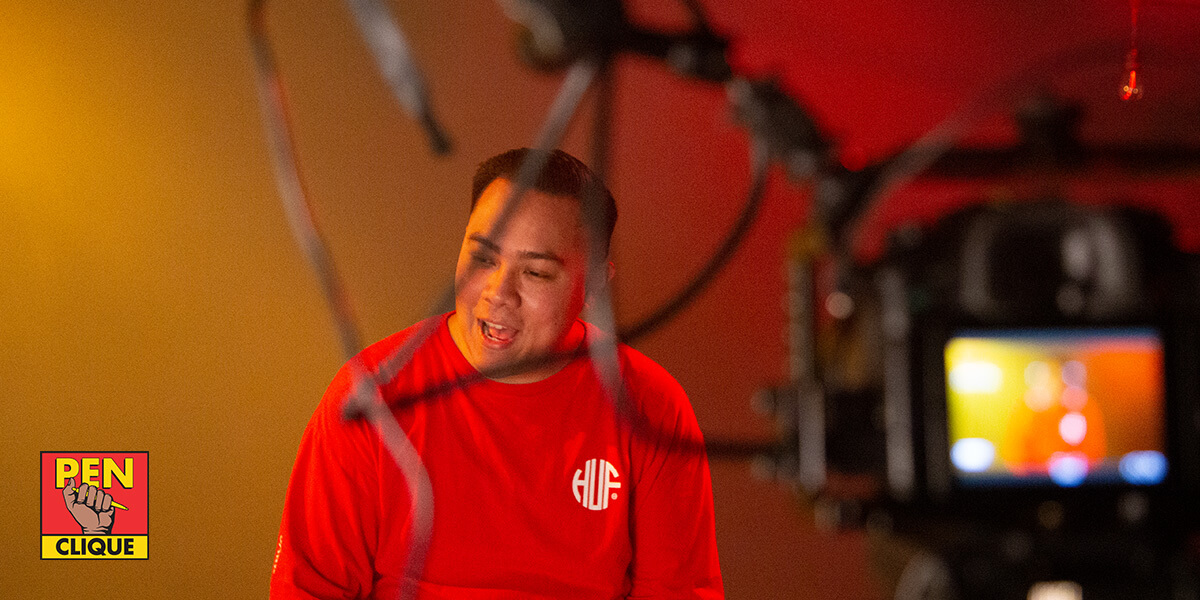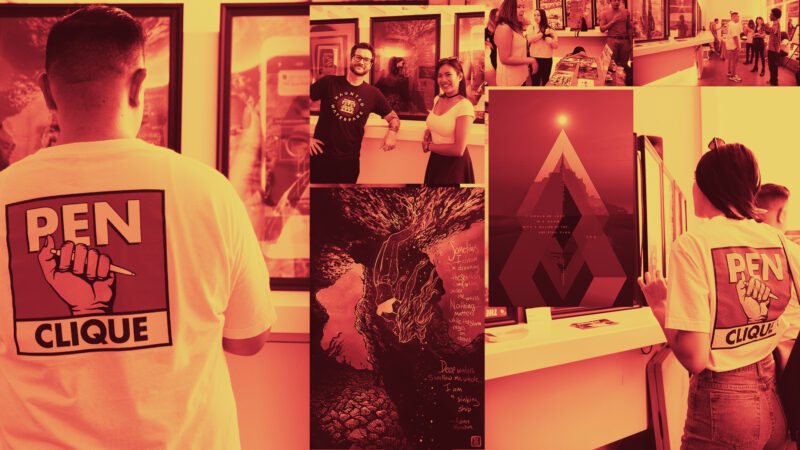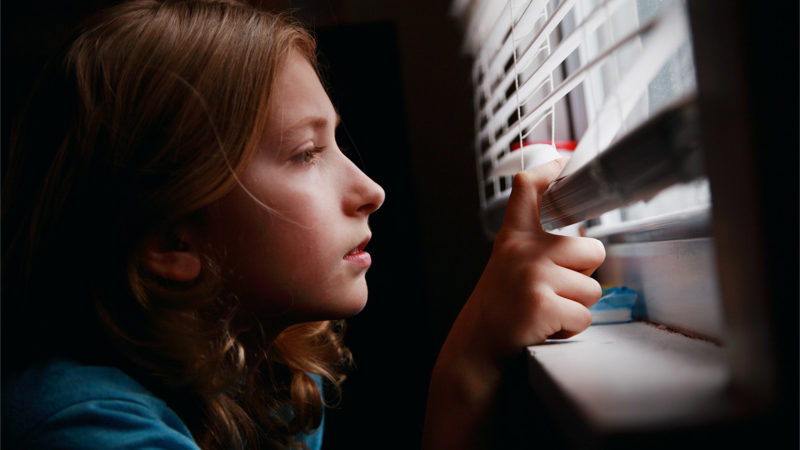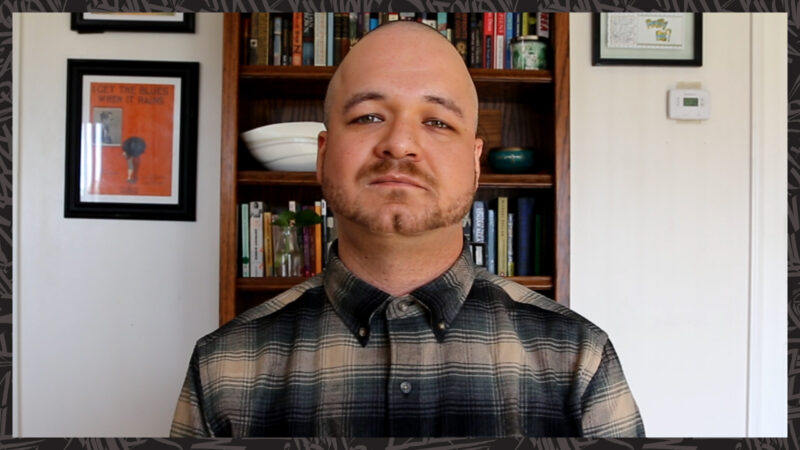“The most popping poetry show in the known universe.”
Something we say a lot at Pen Clique. It has gone from being a tagline, to a call to arms; a standard we are trying to set for ourselves and for what is one of the most important arts we have had in our lives. How do we display poetry in the best way possible, how do we actually live up to calling ourselves “the most popping poetry show” anywhere? We took a year to polish and pursue a standard for Pen Clique and for Poets, through trying to bring a production-team’s worth of work to a small garage and this show we love so much.


I was fortunate enough to move into a house with garage, which we immediately saw as potential to build the set we wanted to. We did the first season of the show mobile, going wherever was most convenient for the poets, bouncing from Kuya’s place in LA, my place in the San Gabriel Valley, or to Poets’ respective homes. We would arrive, assess the space for where we could set up shop, improvise camera and mic positions, then do the best we could with what we had. That became the most important lesson in all of the first season: Do whatever we could with WHAT WE HAD. We took that lesson into the new garage, which was bare bones but ready to be transformed. The first thing we did was hang drywall, which was handled by the homies and a lot of community love. We painted the space a neutral colored grey hoping to create the ideal space for lighting, as season one was a mix of concepts and hopes clashing with the reality of different situations. Kuya David had a lighting vision, and with the new space, now had a canvas to act it out upon.


That meant upgrades all around. We did season one with standard work lights with photo bubbles, some color gels, and whatever equipment we could afford cheap and quick. Execution of concept was the propelling force behind season one, Perfection of concept was now the pursuit. Kuya invested in a set of Neewer panel lights giving him control over intensity and barn doors made it possible to get real control over the light direction and bleed. Along with the gels and lights we already had, we now had a way to create new, interesting spaces and vibes with every episode in a more controlled way. We had a family member of one build us a semi circle table, giving Kuya another bit of control in the scheme of video composition, along with the help of new adjustable stools to sit on so we would always remain on an equal level, regardless of height. These little elements Voltron-stacked up to turn Pen clique into a visually consistent and polished poetry mothership, out here bringing the culture to the galaxy.


What good is a show you can’t hear? Although the first season was done cheap and easy, the cheap part of that equation made audio a bit easier, ironically. Dynamic microphones are inexpensive and durable, making them the road-dog’s workhorses in the audio world. Our Shure SM58 took a beating during season one, and dynamic mics, with their inherit lack of sensitivity, was actually an advantage for the inconsistent spaces we were recording in. Now it was time to upgrade, and to get the ball rolling Kuya Hit me with an Audio Technica AT2020 for my birthday. I bought a couple more and we could now fully switch from less sensitive (but durable dynamic microphones) to condenser mics, which were more red-hot sensitive, and allow for a bit more control when enveloping, mixing, or editing audio.
However, we had to address the echo of the space now that the condensers would pick up echoes and room noise. But as most DIY audio warriors know, that can be easily addressed with some scrap carpet on the floor and moving blankets strategically hung on the walls. With our new set, lights, and now audio, we set out to start stacking up episodes.

We would face new challenges as we started recording season 2, but with the new space, and our ability to manipulate most aspects of it, made those challenges easier to address. Some were dealt with by buying new equipment and some were handle DIY as possible, like running a 200 foot ethernet cable from the house to the garage for consistent connectivity. For me at least, the most important lesson we have taken away from it all has been: It is always more important to get content into the world, than to hold up creation with standards and hopes. If we waited to start Pen Clique until we had exactly what we felt we needed or wanted, it may have never happen. Just getting the ball rolling for us was the best way to get the show where we wanted to see it.
And now after a year (and change), along with gallons of blood, sweat, and tears, we are proud to show you what we think is quite literally the most popping poetry podcast in the know universe. See you July 10th.
~ Write-up by Daniel Hees
VIDEO GEAR:
- Panasonic GH5
- Aputure external monitor
- Neewer LED Panels
- Kamerar LED Panel Soft Box
- Colored Gels
- Photography reflectors/diffusers
AUDIO GEAR:
- Audio Technica AT2020 Mic
- Mic pop-screens
- Behringer Headphone Amp + Splitter
- Mixboard: Boss BR-1600CD (discontinued)
Beats by:
- Pen Clique Intro by The Dope Spot – IG @thedopespotstudios
- https://youtu.be/Vaw7Y_MuVmw – Prod. by Guala Beatz
- https://youtu.be/_qzo8fRwWHc – Prod. by Rujay
- https://youtu.be/NFiamihS4B4 – Prod. by Kevin Katana
- Pen Clique Outro by The Dope Spot – IG @thedopespotstudios
You Might also like
-
The Poetry Art Gallery: A Look-Back One Year Later
It’s been a year since producing Los Angeles’ very first poetry art gallery. It seems that even till today I’m still marinating on the event, but here’s what I can admit and reveal about our (overly?) ambitious project, The Poetry Art Gallery.
-
Poetry “Slam” In The Quarantine Era
Virtual open mics and slams via IG live: Not great. The video quality, audio quality, lack of atmosphere, and most importantly the live aspect are all stripped away. My question is: What would the ideal digital open mic and slam look like in the quarantine era?
-
“Crash Course” – A Prose Essay by Daniel Hees
In this essay, Daniel recounts the life-changing accident that brought him to the edge of death and back.



